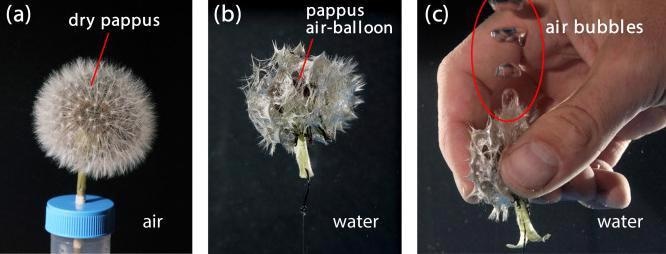Mar 4 2021
During spring, fields are covered with dandelions, a very common plant with toothed leaves and yellow gold flowers.
 Air-encapsulating elastic mechanism of submerged Taraxacum blowballs. Image Credit: University of Trento.
Air-encapsulating elastic mechanism of submerged Taraxacum blowballs. Image Credit: University of Trento.
When the flowers wither, they become fluffy white seed heads, similar to small parachutes, scattered throughout by the wind. With the scientific name Taraxacum officinale, this plant has inspired legends and poets and has been utilized for centuries as a natural remedy for several ailments.
Currently, a study carried out at the University of Trento takes inspiration from dandelions to create new engineered materials. The air-trapping ability of dandelion clocks immersed in water has been quantified, for the first time, in the laboratory.
The breakthrough opens the door for the creation of new and sophisticated devices and technologies that could be utilized in an extensive range of applications, for instance, to make materials or devices that retain air bubbles underwater.
The study was collaborated by Nicola Pugno, professor at the University of Trento and coordinator of the Laboratory of Bio-inspired, Bionic, Nano, Meta Materials and Mechanics at the Department of Civil, Environmental and Mechanical Engineering.
The finding gained international prominence by Materials Today Bio, a multidisciplinary journal that focuses on the interface between biology and materials science, physics, chemistry, medicine and engineering.
Diego Misseroni and I started to work on a discovery that my daughter made, in her first year in high school. She noticed that dandelion clocks, when submerged by water, turn silvery because they trap air. We have quantified this discovery. For the first time, we have measured the air trapping capacity of dandelion clocks in a laboratory setting. This paper demonstrated that kids and young adults can make significant discoveries by observing nature.
Nicola Pugno, Professor, University of Trento
The researchers noted that when dandelions were immersed in water, the soft seed heads became silver in color, turned thinner, and took the shape of a rhombus. Then, the researchers created an analytical model to quantify the flower’s mechanical properties to imitate them and create re-engineered materials that resembled dandelions.
This discovery lays the foundation for bioinspired engineering to look for various chances, like miniaturized parachute-like elements to design novel devices and lightweight, advanced and affordable technological solutions to capture and transport air bubbles underwater. For instance, such materials could be utilized in underwater operations.
Air-encapsulating elastic mechanism of submerged Taraxacum blowballs
This video shows the reversible air-trapping compliant mechanism. In particular, the compliant mechanism discussed in the study brings new bioinspired insights towards new related technological solutions for underwater air-trapping and air-bubbles transportation. Video Credit: University of Trento.
Journal Reference:
Pugno, M. C., et al. (2021) Air-encapsulating elastic mechanism of submerged Taraxacum blowballs. Materials Today Bio. doi.org/10.1016/j.mtbio.2021.100095.